 |
|
 |
�@Ieyasu Tokugawa is said to have originally invited the fishermen who developed a fishing village out of a naturally created bay. This was also the beginning of Tsukuda.Tsukuda is well-known for its �gTsukuda-ni,�h fish and shellfish boiled in sweetened soy sauce. Lacquerware from Tsukuda is also known as �gEdo lacquerware�h, popular and used by everyone, from lords to commoners. Today, we have interviewed Maestro Yasuhide Nakajima, the 11th owner of the �gNakajima Lacquerware house�h in Tsukuda. |
 |
 |
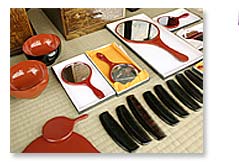
|
| About Edo Lacquerware |
 |
 |
|
�@Lacquerware was first loved among the feudal lords and generals, and later became popular amongst the commoners as well. Different from the laquerware from other regions such as Wajima, or Aizu where the work is divided among different people, Edo lacquerware is all done by the same person.Household effects for feudal lords were also ordered during the Edo period. Today, teacup saucers, tea containers, mirror stands, hand mirrors, Japanese hair sticks or incense cases are created. Edo octangular chopsticks that use ebonywood or sandalwood are also popular items.
�@ |
|
|
 |
| Until I became the 11th owner of the House |
 |
�@The establishment of the Lacquerware house Nakajima is said to have been during the era of Yoshimune Tokugawa (1716-1745), so the house has a 300 year history. It was first run in Nihonbashi, and then it moved to Tsukuda after the war.Our shop and atelier is in Tsukuda 1-chome today. I was born in 1943 and grew up watching my father, the 10th owner, creating his works. After my graduation from junior high school, I joined to be trained under another maestro.Normally, to�gsteal technique rather than be taught�his said to be the sign of a good craftsman, but my master taught me the variety of techniques and experiences he learned through Wajima, Aizu, and Edo.I spent two years under him, and then started helping my father.I am fortunate to be in a traditional shop, since our shop still preserves high quality materials such as rice paper or wood that we can�ft find today, and I can see my craftsmen improving their skills as they get high quality orders made.
|
|
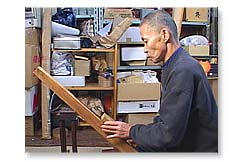 |
 |
 |
 |
 |
 |
 |
| |
|
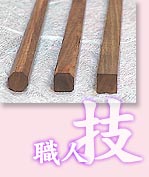
�@There are more than 30 processes to finish one lacquerware piece. Once lacquered, it needs to be dried a whole day.Today, I will show how to make Edo octangular chopsticks. First, shave the ebonywood or sandalwood into a square shape. Stablize it on the board, and then shave the four corners to make octangular. Make the point of the chopstick by polishing it with sandpaper. It�fs still roughly shaved, so use special sandpaper which goes only in one direction for the polish, and finish it with clothes. Using these octangular chopstics, you can pick small beans or Kon-nyaku (devil tongue) without slipping. I am so honored to offer the best quality chopsticks made using antique materials today.
I can also show you lacquer coating today. To begin, melt the lacquer into terps. Apply it onto a brush made of hair, and filter it with rice paper to get rid of rubbish and dust to make the lacquer pure.
Start coating by mast take the part I should not coat.Then, dry for a day.Lacquering does require patience.When shaving the wood, it feels like I am talking with the tree since each wood is different. Also, lacquer firms up, absorbing moisture and oxygen naturally, unlike chemical coatings. Therefore, I feel I am dealing with a living creature.
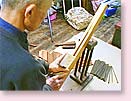 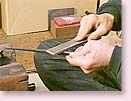 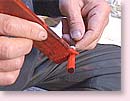
| 1.Shave 4 corners, make octangle. |
|
2.Polish the points of the chopsticks. |
|
3.Coat lacquer over. |
|
|
|
|
 |
 |
 |
 |
 |
 |
|
 |

|
| As a Lacquer craftperson |
 |
 |
|
�@It is a thrill for a craftsperson to create long-lasting beautiful products using the best materials. When customers tell me, �gOh, you made such a good product,�h I enjoy the moment to the fullest. There is this extreme method called �gDakkan-sitsu,�h where you coat lacquer onto pasted hemp clothes and rice paper.My ultimate goal is to make good products using this method.Since we are using lacquer, a naturally made liquid from trees, lacquerware gets differences in texture as it gets used. 100-year old products are much better than newly made ones. I hope to satisfy customers who enjoy the best quality.
�@ |
|
|
 |
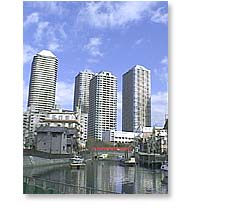
|
| My Relation with Tsukuda |
 |
 |
|
�@Tsukuda started as a fishing village, and it developed into a very unique town from the contrast between the old atmosphere and the highrise apartments. I was born and raised here, and it feels natural to live as a lacquer craftperson in this place. Sometime, those who move to the area stop by and buy at first glance. I am grateful to be surrounded by those people who can sense the best quality here in Tsukuda.
�@ |
|
|
|
 |
 |
 |
 |
| |
 |
|
 |
Nakajima Lacquerware house
Collections for octangular chopsticks varies from sandalwoodchopsticks (10,000 yen), ebonywood chopsticks for fathers (15,000 yen), and for mothers (13,000 yen). Tea cup saucers (68,000 yen), Vases (58,000), large hand mirrors (18,000 yen), small drawers (78,000 yen) and Buddhist Altars (120,000 yen) are available. |
 |
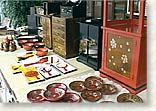 1-4-12 Tsukuda, Chuo-ku 1-4-12 Tsukuda, Chuo-ku
Phone/FAX for atelier�F03-3531-6868
Phone/FAX for the shop�F03-3534-1477
Office hour�F10:00�`18:00
Tsukishima station/Yurakucho-line or Oedo-like |
|
|
 |
 |
 |
|
 |
|
 |